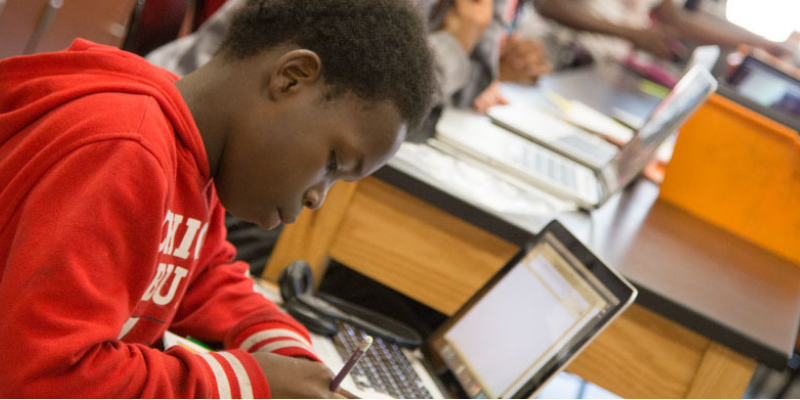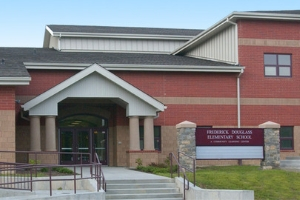Reframe: Episode 54

How Frederick Douglass Elementary is Changing the Way School Works

James Loy:
This is Reframe, the podcast from the College of Education, Health and Society on the campus of Miami University in Oxford, Ohio.
Many teachers and students still experience school in a very similar way. They fill out worksheets, and shuffle through flashcards, and take pop quizzes. The curriculum is often largely scripted, and it can feel like there’s little room for autonomy.
It’s a model that schools have followed for generations, and one that, until recently, students at Frederick Douglass Elementary experienced as well. But today, things at Frederick Douglass are a little different. Here, the teachers and administrators are trying to change the way school works. And it’s starting to pay off.
(Music fade)
It’s 9am on a Friday morning, and students throughout the school are working on all kinds of imaginative projects.
In one class, students are learning about urban development by designing a 3D model of their local neighborhood. In another, social studies students demonstrate their knowledge of agricultural advancements by proudly show off the highly detailed Aztec villages they built. Soon, they’ll also be scripting and recording their own talk shows to reenact even more historical aspects of this ancient culture.
Downstairs, second-grade students are learning about black leaders and making African kente cloths to add to their own freedom quilt. According to their teacher, the goal is to help the students understand themselves, by understanding where they come from, so they’ll know where they’re going, she says, which is actually a pretty good way to describe the kind of journey this entire school is on.
Because things here are changing.
Frederick Douglass is part of Cincinnati Public Schools. It serves grades K-6, and it’s located in one of the city’s most culturally diverse neighborhoods. Many students come from low income or underserved areas. And not long ago, it was ranked as a failing school by the Ohio Department of Education.
Today, however, the school has risen from an F to a B in Closing the Gap. It’s also no longer being targeted by Ohio as a warning school. It’s been removed from that list. And Douglass’ long history of chronic absenteeism is finally going down.
The school Principal and Miami University graduate, Jeffery Hall, says that’s huge. These are three major successes for the entire school, and the district. And it’s a big deal.
So the kind of engagement now happening across Douglass is all part of a larger plan to rethink teaching and learning. And so far, it’s working.
While the turnaround is still ongoing, much of the progress can be traced back to Principal Hall’s vision to set higher expectations and to offer more opportunities, which has led to several key programs, and partnerships, and approaches that have really helped transform the school’s entire culture.
The school administration says things are “110%” different now, and the evidence is everywhere.
A new contemplative arts and sciences program, for example, was introduced to help students build cognitive skills such as self-awareness and self-control. And an award-winning dance company from Dayton, Ohio, was brought on to teach students how movement and motion can increase focus and productivity.
A new partnership with the nearby Walnut Hills High School --which is consistently ranked among the top 100 public high schools in the entire country – also allowed Douglass to offer 20 new after-school activities and mentorship programs including swimming, choir, robotics, 4-H, gardening, and more.
Principal Hall also looked back to his own university, where he had plans to establish a relationship with Miami’s department of teacher education.
Jeffery Hall:
I wanted to establish a relationship with Miami University and Frederick Douglass Elementary. I wanted to do something game-changing in the educational field. I mean, the goal was to be . . . is to be the number one elementary school in the state of Ohio. And I know it's going to take some non-traditional strategies to get us there. So I was thinking … I said, “Hey, most corporations -- Fortune 500 corporations -- have test facilities. And I said, “I want to be a test facility for Miami University students that want to be teachers in our urban setting.”
I want to do that here at Douglass. So we began to work towards becoming a professional development school. We established a relationship, and we began to change the culture and move in the right direction, to try to close the achievement gap with the young people here Frederick Douglass Elementary.
James Loy:
This partnership between Douglass and Miami University began nearly 4 years ago now, and Principal Hall says it’s been beneficial to everyone involved.
Jeffery Hall:
It helps. It’s a win for the university and it’s a win for our school and the school district.
James Loy:
The Miami students get professional experience in real classrooms, and several have already been hired on as full-time Douglass teachers. Of course, the elementary school benefits from the extra assistance. But Miami faculty also host professional development workshops to keep teachers up on current educational trends.
But perhaps the most significant non-traditional change has been the way Douglass students now engage with the actual classroom content, which has begun to emphasize an approach called project-based learning.
Rather than relying on a scripted curriculum or standardized lesson plans, project-based learning creates educational experiences that are richer and more nuanced. Proponents say project-based learning helps students develop academically and emotionally by focusing on critical thinking, problem- solving, and teamwork skills. And it often uses culturally relevant topics, and real-world challenges, and even local issues to encourage students to explore their own curiosity and creativity.
So remember those students who will be designing 3D models of their local neighborhood? They’re actually replicating a successful project that Douglass Educator Zoe Scaglia started last year. Her students found it to be an engaging lesson on urban development not only because it covered the topic of urban development. But also because it connected to another important issue in their life.
Here’s Scaglia talking about what the class did last year, and what they’re about to do again.
Zoe Scaglia:
So last year -- and I’m about to do like another version of it -- last year we made a 3D model out of recycled materials of the Walnut Hills neighborhood were in. We researched it. We partnered with the sixth grade class. We made a 3D model. And then after, we talked about what buildings were missing, so we could talk about the gentrification of their neighborhoods, which I thought was a really powerful way for them to process what's going on. Because last year, there was a … like, a whole lot of new development. And so, it was really powerful to have the students kind of discuss it. And then, to go with it, we wrote a poem, an “I Am” poem. So the students were able to kind of talk about themselves and their poem. And then, at the end, it said “I am Walnut Hills” to represent, like, this is what the neighborhood looks like to them, and that they're part of the neighborhood.
James Loy:
And when the social studies class studied Aztec agriculture by building their own replicates of Aztec villages, and by scripting and producing their own videos, the project became far more immersive than the kind of worksheet exercises that you might find in a more typical classroom.
Here’s their teacher, Lynn Collins, explaining what her students did.
Lynn Collins:
What the task was for the kids, the question that I posed to them is: As historians, should we study the Aztec Indians for their agricultural advances? Or should we focus in on human sacrifice practices?
So they had to get in and learn, first of all, what was a historian, and second, what was human sacrifice and what was agriculture? And then, what did the Aztecs do, agriculturally, that made that so important? And why did they have human sacrifice?
So then, they're at a point right now where they're getting ready to state their opinion and write an essay on it. They're also, right now, putting together a video, where they've created the script for a talk show, and they have a chief that does the human sacrifice and they have a chief in charge of the agriculture. And they interview those two chiefs on why they do those things. But the essence is: they wrote that script. So they had to know the answers. So, to have them be able to come out here and construct this, and build it, and videotape it, is just as valuable as a learning tool as for me to open a textbook and read a chapter with them.
James Loy:
These projects are just a snapshot, just a few of the things happening across Douglass today.
Soon, Principal Hall wants to integrate more technology, which he wants to use to collaborate with even more schools, globally even. He also hopes to expand the partnership with Miami University. And the momentum behind the school’s relationship with the students and with the community only continues to build.
Jeffery Hall:
We're a work in progress. We're not there. And it's going to be something that we continue to revisit. Because if you take your eye off the prize, I mean, you know, things can easily fall back. Because it's easy for people to go back to their comfort zone. So, we have to constantly continue to talk about the culture, and continue to change the culture, and revisit. And the things that helped us to change, and helped us to be successful, we have to make sure we can we continue to do those things so we can be successful. And we also have to remember, we're not number one yet. So we still have a lot of work to do.
James Loy:
We want to thank Douglass Elementary for inviting us into their school and allowing us to meet some of their teachers and students. This is the Reframe podcast. If you enjoyed this episode, please share it with a friend. We have many more episodes available for free on Apple Podcasts and on Google Play Music.

